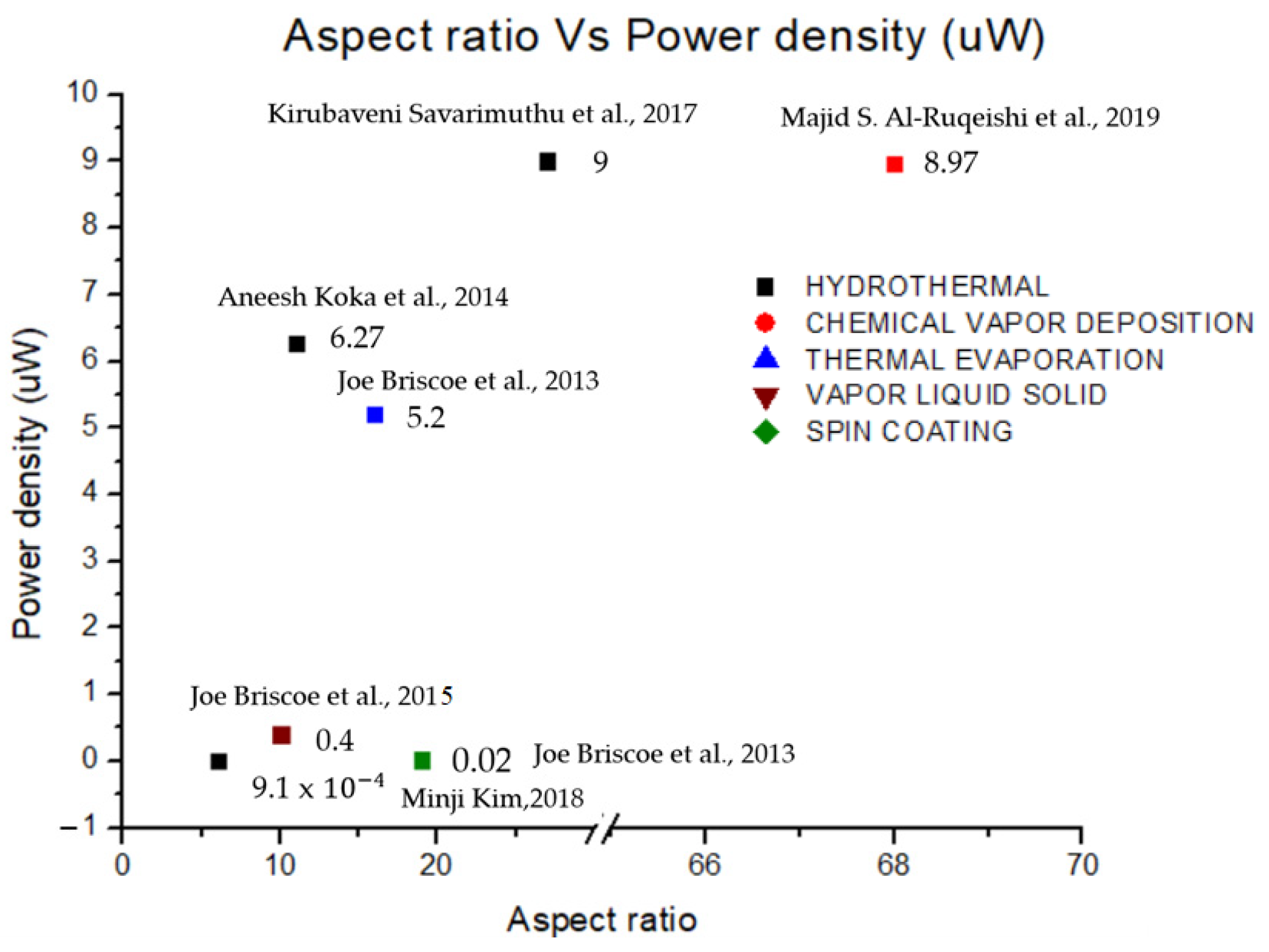Towards a Highly Efficient ZnO Based Nanogenerator
Abstract
1. Introduction
2. Piezoelectric Nanogenerator (PENGs)
3. Types of Piezoelectric Material in NGs
3.1. Zinc Oxide (ZnO)
3.2. Barium Titanate (BaTiO3)
3.3. Lead Zirconate Titanate (PZT)
3.4. Indium Nitride (InN)
3.5. Other Piezoelectric Materials
4. Effect of Dopant on ZnO Nanorods (NRs) Piezoelectric Nanogenerator (PENGs)
4.1. Silver-Doped (Ag-Doped) ZnO Nanorods (NRs)
4.2. Aluminium Doped (Al-Doped) ZnO Nanorods (NRs)
4.3. Nickel Doped (Ni-Doped) ZnO Nanorods (NRs)
4.4. Rare Earth Material ZnO Nanorods (NRs)
4.5. Other Dopants in ZnO Nanorods (NRs)
5. Synthesis Techniques of Growth Process ZnO
5.1. Chemical Vapor Deposition (CVD) Technique
5.2. Hydrothermal Technique
5.3. Electrochemical Deposition Technique (ECD)
6. Recent Technology in Piezoelectric Nanogenerators (PENG)
6.1. Doping
6.2. Areal Density
6.3. Interfacial Modification
6.4. Combination Method
7. Discussion
8. Conclusions
Author Contributions
Funding
Data Availability Statement
Conflicts of Interest
References
- Noorasid, N.; Arith, F.; Mustafa, A.; Azam, M.; Mahalingam, S.; Chelvanathan, P.; Amin, N. Current advancement of flexible dye sensitized solar cell: A review. Optik 2022, 254, 168089. [Google Scholar] [CrossRef]
- Owusu, P.A.; Asumadu-Sarkodie, S. A review of renewable energy sources, sustainability issues and climate change mitigation. Cogent Eng. 2016, 3, 1167990. [Google Scholar] [CrossRef]
- Nguyen, V.; Zhu, R.; Yang, R. Environmental effects on nanogenerators. Nano Energy 2015, 14, 49–61. [Google Scholar] [CrossRef]
- Lin, Z.; Chen, J.; Yang, J. Recent Progress in Triboelectric Nanogenerators as a Renewable and Sustainable Power Source. J. Nanomater. 2016, 2016, 5651613. [Google Scholar] [CrossRef]
- Fan, F.-R.; Tian, Z.-Q.; Wang, Z.L. Flexible triboelectric generator. Nano Energy 2012, 1, 328–334. [Google Scholar] [CrossRef]
- Wang, Z.J.; Wang, D.-J. An RF field pattern with improved B1 amplitude homogeneity. Concepts Magn. Reson. Part B 2005, 24, 1–5. [Google Scholar] [CrossRef]
- Hu, Y.; Wang, Z.L. Recent progress in piezoelectric nanogenerators as a sustainable power source in self-powered systems and active sensors. Nano Energy 2015, 14, 3–14. [Google Scholar] [CrossRef]
- Bogue, R. Energy harvesting: A review of recent developments. Sens. Rev. 2015, 35, 1–5. [Google Scholar] [CrossRef]
- Soin, N. Magnetic Nanoparticles-Piezoelectric Polymer Nanocomposites for Energy Harvesting; Elsevier Inc.: Amsterdam, The Netherlands, 2018. [Google Scholar]
- Bayramol, D.V.; Soin, N.; Shah, T.; Siores, E.; Matsouka, D.; Vassiliadis, S. Energy Harvesting Smart Textiles; Springer: Berlin/Heidelberg, Germany, 2017; pp. 199–231. [Google Scholar]
- Harstad, S.; D’Souza, N.; Soin, N.; El-Gendy, A.A.; Gupta, S.; Pecharsky, V.K.; Shah, T.; Siores, E.; Hadimani, R.L. Enhancement of β-phase in PVDF films embedded with ferromagnetic Gd5Si4 nanoparticles for piezoelectric energy harvesting. AIP Adv. 2017, 7, 056411. [Google Scholar] [CrossRef]
- Soin, N.; Shah, T.H.; Anand, S.C.; Geng, J.; Pornwannachai, W.; Mandal, P.; Reid, D.; Sharma, S.; Hadimani, R.L.; Bayramol, D.V.; et al. Novel “3-D spacer” all fibre piezoelectric textiles for energy harvesting applications. Energy Environ. Sci. 2014, 7, 1670–1679. [Google Scholar] [CrossRef]
- Volk, J.; Nagata, T.; Erdélyi, R.; Bársony, I.; Tóth, A.L.; Lukács, I.E.; Czigány, Z.; Tomimoto, H.; Shingaya, Y.; Chikyow, T. Highly Uniform Epitaxial ZnO Nanorod Arrays for Nanopiezotronics. Nanoscale Res. Lett. 2009, 4, 699–704. [Google Scholar] [CrossRef]
- Dagdeviren, C.; Li, Z.; Wang, Z.L. Energy Harvesting from the Animal/Human Body for Self-Powered Electronics. Annu. Rev. Biomed. Eng. 2017, 19, 85–108. [Google Scholar] [CrossRef]
- Soin, N.; Anand, S.; Shah, T. Energy Harvesting and Storage Textiles, 2nd ed.; Elsevier Ltd.: Amsterdam, The Netherlands, 2016. [Google Scholar]
- Bowen, C.R.; Kim, H.A.; Weaver, P.M.; Dunn, S. Piezoelectric and ferroelectric materials and structures for energy harvesting applications. Energy Environ. Sci. 2013, 7, 25–44. [Google Scholar] [CrossRef]
- Wan, C.; Bowen, C.R. Multiscale-structuring of polyvinylidene fluoride for energy harvesting: The impact of molecular-, micro- and macro-structure. J. Mater. Chem. A 2017, 5, 3091–3128. [Google Scholar] [CrossRef]
- Ramadan, K.S.; Sameoto, D.; Evoy, S. A review of piezoelectric polymers as functional materials for electromechanical transducers. Smart Mater. Struct. 2014, 23, 033001. [Google Scholar] [CrossRef]
- Xu, Y.; Yu, Q.; Li, J.-F. A facile method to fabricate vertically aligned (K,Na)NbO3 lead-free piezoelectric nanorods. J. Mater. Chem. 2012, 22, 23221–23226. [Google Scholar] [CrossRef]
- Singh, S.; Tripathi, R.K.; Gupta, M.K.; Dzhardimalieva, G.I.; Uflyand, I.E.; Yadav, B. 2-D self-healable polyaniline-polypyrrole nanoflakes based triboelectric nanogenerator for self-powered solar light photo detector with DFT study. J. Colloid Interface Sci. 2021, 600, 572–585. [Google Scholar] [CrossRef]
- Singh, S.; Yadav, P.; Gupta, M.K.; Dzhardimalieva, G.I.; Yoon, J.; Maiti, C.; Yadav, B.C. Gigantic stimulation in response by solar irradiation in self-healable and self-powered LPG sensor based on triboelectric nanogenerator: Experimental and DFT computational study. Sens. Actuators B: Chem. 2022, 359, 131573. [Google Scholar] [CrossRef]
- Thakre, A.; Kumar, A.; Song, H.-C.; Jeong, D.-Y.; Ryu, J. Pyroelectric Energy Conversion and Its Applications—Flexible Energy Harvesters and Sensors. Sensors 2019, 19, 2170. [Google Scholar] [CrossRef]
- Li, X.; Liang, R.; Tao, J.; Peng, Z.; Xu, Q.; Han, X.; Wang, X.; Wang, C.; Zhu, J.; Pan, C.; et al. Flexible Light Emission Diode Arrays Made of Transferred Si Microwires-ZnO Nanofilm with Piezo-Phototronic Effect Enhanced Lighting. ACS Nano 2017, 11, 3883–3889. [Google Scholar] [CrossRef]
- Li, X.; Chen, M.; Yu, R.; Zhang, T.; Song, D.; Liang, R.; Zhang, Q.; Cheng, S.; Dong, L.; Pan, A.; et al. Enhancing Light Emission of ZnO-Nanofilm/Si-Micropillar Heterostructure Arrays by Piezo-Phototronic Effect. Adv. Mater. 2015, 27, 4447–4453. [Google Scholar] [CrossRef] [PubMed]
- Pandey, R.K.; Dutta, J.; Brahma, S.; Rao, B.; Liu, C.-P. Review on ZnO-based piezotronics and piezoelectric nanogenerators: Aspects of piezopotential and screening effect. J. Phys.: Mater. 2021, 4, 044011. [Google Scholar] [CrossRef]
- Wen, X.; Wu, W.; Pan, C.; Hu, Y.; Yang, Q.; Wang, Z.L. Development and progress in piezotronics. Nano Energy 2015, 14, 276–295. [Google Scholar] [CrossRef]
- Lu, J.; Xu, C.; Li, F.; Yang, Z.; Peng, Y.; Li, X.; Que, M.; Pan, C.; Wang, Z.L. Piezoelectric Effect Tuning on ZnO Microwire Whispering-Gallery Mode Lasing. ACS Nano 2018, 12, 11899–11906. [Google Scholar] [CrossRef]
- Jiji, G. A retrospect on the role of piezoelectric nanogenerators in the development of the green world. RSC Adv. 2017, 7, 33642–33670. [Google Scholar] [CrossRef]
- Song, H. Fabrication and Characterisation of Electrospun Polyvinylidene Fluoride (PVDF) Nanocomposites for Energy Harvesting Applications; Brunel University London: London, UK, 2016; p. 147. [Google Scholar]
- Ma, J.; Hu, J.; Li, Z.; Nan, C.-W. Recent Progress in Multiferroic Magnetoelectric Composites: From Bulk to Thin Films. Adv. Mater. 2011, 23, 1062–1087. [Google Scholar] [CrossRef]
- Hu, J.-M.; Li, Z.; Wang, J.; Ma, J.; Lin, Y.H.; Nan, C.W. A simple bilayered magnetoelectric random access memory cell based on electric-field controllable domain structure. J. Appl. Phys. 2010, 108, 043909. [Google Scholar] [CrossRef]
- Ma, J.; Shi, Z.; Nan, C.-W. Magnetoelectric Properties of Composites of Single Pb(Zr,Ti)O3 Rods and Terfenol-D/Epoxy with a Single-Period of 1-3-Type Structure. Adv. Mater. 2007, 19, 2571–2573. [Google Scholar] [CrossRef]
- Fujii, I.; Nakashima, K.; Kumada, N.; Wada, S. Structural, dielectric, and piezoelectric properties of BaTiO3-Bi(Ni1/2Ti1/2)O3 ceramics. J. Ceram. Soc. Jpn. 2012, 120, 30–34. [Google Scholar] [CrossRef]
- Briscoe, J.; Dunn, S. Piezoelectric nanogenerators—A review of nanostructured piezoelectric energy harvesters. Nano Energy 2015, 14, 15–29. [Google Scholar] [CrossRef]
- Zhu, G.; Wang, A.C.; Liu, Y.; Zhou, Y.; Wang, Z.L. Functional Electrical Stimulation by Nanogenerator with 58 V Output Voltage. Nano Lett. 2012, 12, 3086–3090. [Google Scholar] [CrossRef] [PubMed]
- Qi, Y.; McAlpine, M.C. Nanotechnology-enabled flexible and biocompatible energy harvesting. Energy Environ. Sci. 2010, 3, 1275–1285. [Google Scholar] [CrossRef]
- Wang, Z.L.; Wu, W. Nanotechnology-Enabled Energy Harvesting for Self-Powered Micro-/Nanosystems. Angew. Chem. Int. Ed. 2012, 51, 11700–11721. [Google Scholar] [CrossRef]
- Delgado-Alvarado, E.; Elvira-Hern, E.A.; Huerta-Chua, J.; Vázquez-Leal, H.; Mart, J.; Garc, P.J. Recent Progress of Nanogenerators for Green Energy Harvesting: Performance, Applications and Challenges. Nanomaterials 2022, 12, 2549. [Google Scholar] [CrossRef]
- Wang, Z.L.; Song, J. Piezoelectric Nanogenerators Based on Zinc Oxide Nanowire Arrays. Science 2006, 312, 242–246. [Google Scholar] [CrossRef]
- Wang, X.; Song, J.; Liu, J.; Wang, Z.L. Direct-Current Nanogenerator Driven by Ultrasonic Waves. Science 2007, 316, 102–105. [Google Scholar] [CrossRef]
- Hu, D.; Yao, M.; Fan, Y.; Ma, C.; Fan, M.; Liu, M. Strategies to achieve high performance piezoelectric nanogenerators. Nano Energy 2019, 55, 288–304. [Google Scholar] [CrossRef]
- Bouvet-Marchand, A.; Graillot, A.; Volk, J.; Dauksevicius, R.; Sturm, C.; Grundmann, M.; Saoutieff, E.; Viana, A.; Christian, B.; Lebedev, V.; et al. Design of UV-crosslinked polymeric thin layers for encapsulation of piezoelectric ZnO nanowires for pressure-based fingerprint sensors. J. Mater. Chem. C 2017, 6, 605–613. [Google Scholar] [CrossRef]
- Al-Ruqeishi, M.; Mohiuddin, T.; Al-Habsi, B.; Al-Ruqeishi, F.; Al-Fahdi, A.; Al-Khusaibi, A. Piezoelectric nanogenerator based on ZnO nanorods. Arab. J. Chem. 2019, 12, 5173–5179. [Google Scholar] [CrossRef]
- Savarimuthu, K.; Rajamanickam, G.; Shankararajan, R.; Perumal, R.; Rayarfrancis, A. Experimental Study on Flexible ZnO Based Nanogenerator Using Schottky Contact for Energy Harvesting Applications. IEEE Trans. Nanotechnol. 2017, 16, 469–476. [Google Scholar] [CrossRef]
- Briscoe, J.; Jalali, N.; Woolliams, P.; Stewart, M.; Weaver, P.M.; Cain, M.; Dunn, S. Measurement techniques for piezoelectric nanogenerators. Energy Environ. Sci. 2013, 6, 3035–3045. [Google Scholar] [CrossRef]
- Cao, P.; Yang, Z.; Navale, S.; Han, S.; Liu, X.; Liu, W.; Lu, Y.; Stadler, F.; Zhu, D. Ethanol sensing behavior of Pd-nanoparticles decorated ZnO-nanorod based chemiresistive gas sensors. Sens. Actuators B Chem. 2019, 298, 126850. [Google Scholar] [CrossRef]
- Pearton, S.; Norton, D.; Ip, K.; Heo, Y.; Steiner, T. Recent progress in processing and properties of ZnO. Superlattices Microstruct. 2003, 34, 3–32. [Google Scholar] [CrossRef]
- Koka, A.; Zhou, Z.; Sodano, H.A. Vertically aligned BaTiO3nanowire arrays for energy harvesting. Energy Environ. Sci. 2013, 7, 288–296. [Google Scholar] [CrossRef]
- Wu, W.; Bai, S.; Yuan, M.; Qin, Y.; Wang, Z.L.; Jing, T. Lead Zirconate Titanate Nanowire Textile Nanogenerator for Wearable Energy-Harvesting and Self-Powered Devices. ACS Nano 2012, 6, 6231–6235. [Google Scholar] [CrossRef]
- Ku, N.-J.; Liu, G.; Wang, C.-H.; Gupta, K.; Liao, W.-S.; Ban, D.; Liu, C.-P. Optimal geometrical design of inertial vibration DC piezoelectric nanogenerators based on obliquely aligned InN nanowire arrays. Nanoscale 2017, 9, 14039–14046. [Google Scholar] [CrossRef]
- Islam, S.; Zamil, Y.; Mojumder, R.H.; Stampfl, C.; Park, J. Strong tribo-piezoelectric effect in bilayer indium nitride (InN). Sci. Rep. 2021, 11, 18669. [Google Scholar] [CrossRef]
- Mishra, S.; Supraja, P.; Sankar, P.; Kumar, R.; Prakash, K.; Haranath, D. Controlled synthesis of luminescent ZnS nanosheets with high piezoelectric performance for designing mechanical energy harvesting device. Mater. Chem. Phys. 2021, 277, 125264. [Google Scholar] [CrossRef]
- Parangusan, H.; Bhadra, J.; Al-Thani, N. Flexible piezoelectric nanogenerator based on [P(VDF-HFP)]/PANI-ZnS electrospun nanofibers for electrical energy harvesting. J. Mater. Sci. Mater. Electron. 2021, 32, 6358–6368. [Google Scholar] [CrossRef]
- Banerjee, S.; Bairagi, S.; Ali, S.W. A lead-free flexible piezoelectric-triboelectric hybrid nanogenerator composed of uniquely designed PVDF/KNN-ZS nanofibrous web. Energy 2022, 244, 123102. [Google Scholar] [CrossRef]
- Zhao, B.; Chen, Z.; Cheng, Z.; Wang, S.; Yu, T.; Yang, W.; Li, Y. Piezoelectric Nanogenerators Based on Electrospun PVDF-Coated Mats Composed of Multilayer Polymer-Coated BaTiO3 Nanowires. ACS Appl. Nano Mater. 2022, 5, 8417–8428. [Google Scholar] [CrossRef]
- He, Y.; Wang, H.; Sha, Z.; Boyer, C.; Wang, C.-H.; Zhang, J. Enhancing output performance of PVDF-HFP fiber-based nanogenerator by hybridizing silver nanowires and perovskite oxide nanocrystals. Nano Energy 2022, 98, 107343. [Google Scholar] [CrossRef]
- Mallick, Z.; Saini, D.; Sarkar, R.; Kundu, T.K.; Mandal, D. Piezo-phototronic effect in highly stable lead-free double perovskite Cs2SnI6-PVDF nanocomposite: Possibility for strain modulated optical sensor. Nano Energy 2022, 100, 107451. [Google Scholar] [CrossRef]
- Kim, M.; Wu, Y.S.; Kan, E.C.; Fan, J. Breathable and Flexible Piezoelectric ZnO@PVDF Fibrous Nanogenerator for Wearable Applications. Polymers 2018, 10, 745. [Google Scholar] [CrossRef] [PubMed]
- Qiu, Y.; Lei, J.; Yang, D.; Yin, B.; Zhang, H.; Bian, J.; Ji, J.; Liu, Y.; Zhao, Y.; Luo, Y.; et al. Enhanced performance of wearable piezoelectric nanogenerator fabricated by two-step hydrothermal process. Appl. Phys. Lett. 2014, 104, 113903. [Google Scholar] [CrossRef]
- Aleman, C.K.; Narvaez, J.A.B.; Lopez, G.D.B.; Mercado, C.C. Array pattern effects on the voltage output of vertically aligned BaTiO3 nanotubular flexible piezoelectric nanogenerator. MRS Commun. 2020, 10, 500–505. [Google Scholar] [CrossRef]
- Khan, A.; Abbasi, M.A.; Hussain, M.; Ibupoto, Z.H.; Wissting, J.; Nur, O.; Willander, M. Piezoelectric nanogenerator based on zinc oxide nanorods grown on textile cotton fabric. Appl. Phys. Lett. 2012, 101, 193506. [Google Scholar] [CrossRef]
- Chen, X.; Xu, S.; Yao, N.; Xu, W.; Shi, Y. Potential measurement from a single lead ziroconate titanate nanofiber using a nanomanipulator. Appl. Phys. Lett. 2009, 94, 253113. [Google Scholar] [CrossRef]
- Liu, C.; Yu, A.; Peng, M.; Song, M.; Liu, W.; Zhang, Y.; Zhai, J. Improvement in the Piezoelectric Performance of a ZnO Nanogenerator by a Combination of Chemical Doping and Interfacial Modification. J. Phys. Chem. C 2016, 120, 6971–6977. [Google Scholar] [CrossRef]
- Rafique, S.; Kasi, A.K.; Kasi, J.K.; Aminullah; Bokhari, M.; Shakoor, Z. Fabrication of silver-doped zinc oxide nanorods piezoelectric nanogenerator on cotton fabric to utilize and optimize the charging system. Nanomater. Nanotechnol. 2020, 10, 1847980419895741. [Google Scholar] [CrossRef]
- Chang, W.-Y.; Fang, T.-H.; Tsai, J.-H. Electromechanical and Photoluminescence Properties of Al-doped ZnO Nanorods Applied in Piezoelectric Nanogenerators. J. Low Temp. Phys. 2014, 178, 174–187. [Google Scholar] [CrossRef]
- Vayssieres, L.; Keis, K.; Lindquist, S.-E.; Hagfeldt, A. Purpose-Built Anisotropic Metal Oxide Material: 3D Highly Oriented Microrod Array of ZnO. J. Phys. Chem. B 2001, 105, 3350–3352. [Google Scholar] [CrossRef]
- Fang, T.-H.; Kang, S.-H. Surface and physical characteristics of ZnO:Al nanostructured films. J. Appl. Phys. 2009, 105, 113512. [Google Scholar] [CrossRef]
- Chu, Y.-L.; Young, S.-J.; Ji, L.-W.; Chu, T.-T.; Chen, P.-H. Synthesis of Ni-Doped ZnO Nanorod Arrays by Chemical Bath Deposition and Their Application to Nanogenerators. Energies 2020, 13, 2731. [Google Scholar] [CrossRef]
- Parangusan, H.; Ponnamma, D.; AlMaadeed, M.A.A. Flexible tri-layer piezoelectric nanogenerator based on PVDF-HFP/Ni-doped ZnO nanocomposites. RSC Adv. 2017, 7, 50156–50165. [Google Scholar] [CrossRef]
- Batra, K.; Sinha, N.; Goel, S.; Yadav, H.; Joseph, A.J.; Kumar, B. Enhanced dielectric, ferroelectric and piezoelectric performance of Nd-ZnO nanorods and their application in flexible piezoelectric nanogenerator. J. Alloy. Compd. 2018, 767, 1003–1011. [Google Scholar] [CrossRef]
- Pandey, R.; Khandelwal, G.; Palani, I.A.; Singh, V.; Kim, S.-J. A La-doped ZnO ultra-flexible flutter-piezoelectric nanogenerator for energy harvesting and sensing applications: A novel renewable source of energy. Nanoscale 2019, 11, 14032–14041. [Google Scholar] [CrossRef]
- Batra, K.; Sinha, N.; Kumar, B. Tb-doped ZnO:PDMS based flexible nanogenerator with enhanced piezoelectric output performance by optimizing nanofiller concentration. Ceram. Int. 2020, 46, 24120–24128. [Google Scholar] [CrossRef]
- Sinha, N.; Ray, G.; Bhandari, S.; Godara, S.; Kumar, B. Synthesis and enhanced properties of cerium doped ZnO nanorods. Ceram. Int. 2014, 40, 12337–12342. [Google Scholar] [CrossRef]
- Gupta, M.K.; Lee, J.-H.; Lee, K.Y.; Kim, S.-W. Two-Dimensional Vanadium-Doped ZnO Nanosheet-Based Flexible Direct Current Nanogenerator. ACS Nano 2013, 7, 8932–8939. [Google Scholar] [CrossRef]
- Batra, K.; Sinha, N.; Kumar, B. Ba-doped ZnO nanorods: Efficient piezoelectric filler material for PDMS based flexible nanogenerator. Vacuum 2021, 191, 110385. [Google Scholar] [CrossRef]
- Lee, J.-H.; Lee, K.Y.; Kumar, B.; Kim, S.-W. Synthesis of Ga-Doped ZnO Nanorods Using an Aqueous Solution Method for a Piezoelectric Nanogenerator. J. Nanosci. Nanotechnol. 2012, 12, 3430–3433. [Google Scholar] [CrossRef]
- Sinha, N.; Ray, G.; Godara, S.; Gupta, M.K.; Kumar, B. Enhanced piezoelectric output voltage and Ohmic behavior in Cr-doped ZnO nanorods. Mater. Res. Bull. 2014, 59, 267–271. [Google Scholar] [CrossRef]
- Lam, K.-T.; Chu, Y.-L.; Ji, L.-W.; Hsiao, Y.-J.; Chu, T.-T.; Huang, B.-W. Characterization of nanogenerators based on S-doped zinc oxide nanorod arrays. Microsyst. Technol. 2020, 28, 395–401. [Google Scholar] [CrossRef]
- Ng, Z.-N.; Chan, K.-Y.; Tohsophon, T. Effects of annealing temperature on ZnO and AZO films prepared by sol–gel technique. Appl. Surf. Sci. 2012, 258, 9604–9609. [Google Scholar] [CrossRef]
- Jain, S.; Karmakar, N.; Shah, A.; Shimpi, N.G. Development of Ni doped ZnO/polyaniline nanocomposites as high response room temperature NO2 sensor. Mater. Sci. Eng. B 2019, 247, 114381. [Google Scholar] [CrossRef]
- Fang, T.-H. Physical Properties of ZnO: Al Nanorods for Piezoelectric Nanogenerator Application. Curr. Nanosci. 2010, 6, 505–511. [Google Scholar] [CrossRef]
- Rajabi, M.; Ghorbani, M. Performance evaluation of nanogenerators based on Ag doped ZnO nanorods. Sens. Actuators A Phys. 2017, 266, 338–344. [Google Scholar] [CrossRef]
- Hasanpoor, M.; Aliofkhazraei, M.; Delavari, H. In-situ study of mass and current density for electrophoretic deposition of zinc oxide nanoparticles. Ceram. Int. 2016, 42, 6906–6913. [Google Scholar] [CrossRef]
- Kołodziejczak-Radzimska, A.; Jesionowski, T. Zinc Oxide—From Synthesis to Application: A Review. Materials 2014, 7, 2833–2881. [Google Scholar] [CrossRef]
- Qin, C.; Gu, Y.; Sun, X.; Wang, X.; Zhang, Y. Structural dependence of piezoelectric size effects and macroscopic polarization in ZnO nanowires: A first-principles study. Nano Res. 2015, 8, 2073–2081. [Google Scholar] [CrossRef]
- Cauda, V.; Stassi, S.; Lamberti, A.; Morello, M.; Pirri, C.F.; Canavese, G. Leveraging ZnO morphologies in piezoelectric composites for mechanical energy harvesting. Nano Energy 2015, 18, 212–221. [Google Scholar] [CrossRef]
- Tlemcani, T.S.; Justeau, C.; Nadaud, K.; Poulin-Vittrant, G.; Alquier, D. Deposition Time and Annealing Effects of ZnO Seed Layer on Enhancing Vertical Alignment of Piezoelectric ZnO Nanowires. Chemosensors 2019, 7, 7. [Google Scholar] [CrossRef]
- Joshi, S.; Nayak, M.; Rajanna, K. Effect of post-deposition annealing on transverse piezoelectric coefficient and vibration sensing performance of ZnO thin films. Appl. Surf. Sci. 2014, 296, 169–176. [Google Scholar] [CrossRef]
- Sohn, J.I.; Cha, S.N.; Song, B.G.; Lee, S.; Kim, S.M.; Ku, J.; Kim, H.J.; Park, Y.J.; Choi, B.L.; Wang, Z.L.; et al. Engineering of efficiency limiting free carriers and an interfacial energy barrier for an enhancing piezoelectric generation. Energy Environ. Sci. 2012, 6, 97–104. [Google Scholar] [CrossRef]
- Pham, T.T.; Lee, K.Y.; Lee, J.; Kim, K.H.; Shin, K.S.; Gupta, M.K.; Kumar, B.; Kim, S. Reliable operation of a nanogenerator under ultraviolet light via engineering piezoelectric potential. Energy Environ. Sci 2013, 6, 841–846. [Google Scholar] [CrossRef]
- Cha, S.N.; Seo, J.-S.; Kim, S.M.; Kim, H.J.; Park, Y.J.; Kim, S.-W.; Kim, J.M. Sound-Driven Piezoelectric Nanowire-Based Nanogenerators. Adv. Mater. 2010, 22, 4726–4730. [Google Scholar] [CrossRef]
- Barreca, D.; Bekermann, D.; Comini, E.; Devi, A.; Fischer, R.A.; Gasparotto, A.; Maccato, C.; Sberveglieri, G.; Tondello, E. 1D ZnO nano-assemblies by Plasma-CVD as chemical sensors for flammable and toxic gases. Sens. Actuators B Chem. 2010, 149, 1–7. [Google Scholar] [CrossRef]
- Phan, T.-L.; Yu, S.; Vincent, R.; Dan, N.; Shi, W. Photoluminescence properties of various CVD-grown ZnO nanostructures. J. Lumin 2010, 130, 1142–1146. [Google Scholar] [CrossRef]
- Lee, D.J.; Park, J.Y.; Yun, Y.S.; Hong, Y.S.; Moon, J.H.; Lee, B.-T.; Kim, S.S. Comparative studies on the growth behavior of ZnO nanorods by metalorganic chemical vapor deposition depending on the type of substrates. J. Cryst. Growth 2004, 276, 458–464. [Google Scholar] [CrossRef]
- Kumar, B.; Lee, K.Y.; Park, H.; Chae, S.J.; Lee, Y.H.; Kim, S. Controlled Growth of Semiconducting Nanowire, Nanowall, and Hybrid Nanostructures on Graphene for Piezoelectric Nanogenerators. Acs Nano 2011, 5, 4197–4204. [Google Scholar] [CrossRef] [PubMed]
- Zhang, D.; Wang, C.; Zhang, F. Oxygen pressure and measurement temperature dependence of defects related bands in zinc oxide films. Vacuum 2010, 85, 160–163. [Google Scholar] [CrossRef]
- Menzel, A.; Subannajui, K.; Bakhda, R.; Wang, Y.; Thomann, R.; Zacharias, M. Tuning the Growth Mechanism of ZnO Nanowires by Controlled Carrier and Reaction Gas Modulation in Thermal CVD. J. Phys. Chem. Lett. 2012, 3, 2815–2821. [Google Scholar] [CrossRef]
- Ghosh, M.; Rao, M.G. Growth mechanism of ZnO nanostructures for ultra-high piezoelectric d33 coefficient. Mater. Express 2013, 3, 319–327. [Google Scholar] [CrossRef]
- Vayssieres, L. Growth of Arrayed Nanorods and Nanowires of ZnO from Aqueous Solutions. Adv. Mater. 2003, 15, 464–466. [Google Scholar] [CrossRef]
- Poulin-Vittrant, G.; Oshman, C.; Opoku, C.; Dahiya, A.; Camara, N.; Alquier, D.; Hue, L.-P.T.H.; Lethiecq, M. Fabrication and Characterization of ZnO Nanowire-based Piezoelectric Nanogenerators for Low Frequency Mechanical Energy Harvesting. Phys. Procedia 2015, 70, 909–913. [Google Scholar] [CrossRef]
- Zhang, Y.; Liu, C.; Liu, J.; Xiong, J.; Liu, J.; Zhang, K.; Liu, Y.; Peng, M.; Yu, A.; Zhang, A.; et al. Lattice Strain Induced Remarkable Enhancement in Piezoelectric Performance of ZnO-Based Flexible Nanogenerators. ACS Appl. Mater. Interfaces 2016, 8, 1381–1387. [Google Scholar] [CrossRef]
- Stassi, S.; Cauda, V.; Ottone, C.; Chiodoni, A.; Pirri, C.F.; Canavese, G. Flexible piezoelectric energy nanogenerator based on ZnO nanotubes hosted in a polycarbonate membrane. Nano Energy 2015, 13, 474–481. [Google Scholar] [CrossRef]
- Nour, E.; Sandberg, M.; Willander, M.; Nur, O. Handwriting enabled harvested piezoelectric power using ZnO nanowires/polymer composite on paper substrate. Nano Energy 2014, 9, 221–228. [Google Scholar] [CrossRef]
- Liao, Q.; Zhang, Z.; Zhang, X.; Mohr, M.; Zhang, Y.; Fecht, H.-J. Flexible piezoelectric nanogenerators based on a fiber/ZnO nanowires/paper hybrid structure for energy harvesting. Nano Res. 2014, 7, 917–928. [Google Scholar] [CrossRef]
- Saravanakumar, B.; Kim, S.-J. Growth of 2D ZnO Nanowall for Energy Harvesting Application. J. Phys. Chem. C 2014, 118, 8831–8836. [Google Scholar] [CrossRef]
- Zhang, Z.; Chen, Y.; Guo, J. ZnO nanorods patterned-textile using a novel hydrothermal method for sandwich structured-piezoelectric nanogenerator for human energy harvesting. Phys. E: Low-Dimens. Syst. Nanostructures 2018, 105, 212–218. [Google Scholar] [CrossRef]
- Khan, A.; Hussain, M.; Nur, O.; Willander, M. Mechanical and piezoelectric properties of zinc oxide nanorods grown on conductive textile fabric as an alternative substrate. J. Phys. D Appl. Phys. 2014, 47, 345102. [Google Scholar] [CrossRef]
- Khan, A.; Hussain, M.; Nur, O.; Willander, M. Fabrication of zinc oxide nanoneedles on conductive textile for harvesting piezoelectric potential. Chem. Phys. Lett. 2014, 612, 62–67. [Google Scholar] [CrossRef]
- Zang, W.; Wang, W.; Zhu, D.; Xing, L.; Xue, X. Humidity-dependent piezoelectric output of Al–ZnO nanowire nanogenerator and its applications as a self-powered active humidity sensor. RSC Adv. 2014, 4, 56211–56215. [Google Scholar] [CrossRef]
- Hussain, M.; Abbasi, M.A.; Ibupoto, Z.H.; Nur, O.; Willander, M. The improved piezoelectric properties of ZnO nanorods with oxygen plasma treatment on the single layer graphene coated polymer substrate. Phys. Status Solidi 2014, 211, 455–459. [Google Scholar] [CrossRef]
- Opoku, C.; Dahiya, A.S.; Oshman, C.; Cayrel, F.; Poulin-Vittrant, G.; Alquier, D.; Camara, N. Fabrication of ZnO Nanowire Based Piezoelectric Generators and Related Structures. Phys. Procedia 2015, 70, 858–862. [Google Scholar] [CrossRef]
- Lee, C.-T.; Chiu, Y.-S. Piezoelectric ZnO-nanorod-structured pressure sensors using GaN-based field-effect-transistor. Appl. Phys. Lett. 2015, 106, 073502. [Google Scholar] [CrossRef]
- Lei, J.; Yin, B.; Qiu, Y.; Zhang, H.; Chang, Y.; Luo, Y.; Zhao, Y.; Ji, J.; Hu, L. Flexible piezoelectric nanogenerator based on Cu2O–ZnO p–n junction for energy harvesting. RSC Adv. 2015, 5, 59458–59462. [Google Scholar] [CrossRef]
- Wang, Q.; Yang, D.; Qiu, Y.; Zhang, X.; Song, W.; Hu, L. Two-dimensional ZnO nanosheets grown on flexible ITO-PET substrate for self-powered energy-harvesting nanodevices. Appl. Phys. Lett. 2018, 112, 063906. [Google Scholar] [CrossRef]
- Zhang, X.; Yang, D.; Qiu, Y.; Nie, Y.; Chu, H.; Zhang, H.; Hu, L. Improvement in the Piezoelectric Performance of a ZnO Nanogenerator by a ZnO/Spiro-MeOTAD ps-n Heterojunction. Phys. Status Solidi 2019, 216, 1800717. [Google Scholar] [CrossRef]
- Lu, S.; Liao, Q.; Qi, J.; Liu, S.; Liu, Y.; Liang, Q.; Zhang, G.; Zhang, Y. The enhanced performance of piezoelectric nanogenerator via suppressing screening effect with Au particles/ZnO nanoarrays Schottky junction. Nano Res. 2015, 9, 372–379. [Google Scholar] [CrossRef]
- Pan, C.; Chen, Y.; Hsieh, C.; Lin, C.-H.; Su, C.; Yen, C.; Liu, Z.; Wang, W. Ultrasonic sensing device with ZnO piezoelectric nanorods by selectively electrospraying method. Sens. Actuators A: Phys. 2014, 216, 318–327. [Google Scholar] [CrossRef]
- Hasan, R.; Baek, S.-H.; Seong, K.S.; Kim, J.H.; Park, I.-K. Hierarchical ZnO Nanorods on Si Micropillar Arrays for Performance Enhancement of Piezoelectric Nanogenerators. ACS Appl. Mater. Interfaces 2015, 7, 5768–5774. [Google Scholar] [CrossRef]
- Shin, D.-M.; Tsege, E.L.; Kang, S.H.; Seung, W.; Kim, S.-W.; Kim, H.K.; Hong, S.W.; Hwang, Y.-H. Freestanding ZnO nanorod/graphene/ZnO nanorod epitaxial double heterostructure for improved piezoelectric nanogenerators. Nano Energy 2015, 12, 268–277. [Google Scholar] [CrossRef]
- Shin, C.; Heo, J.; Park, J.; Lee, T.; Ryu, H.; Shin, B.; Lee, W.; Kim, H.-K. The effect of pH on ZnO hydrothermal growth on PES flexible substrates. Phys. E: Low-Dimens. Syst. Nanostructures 2010, 43, 54–57. [Google Scholar] [CrossRef]
- Tao, Y.; Fu, M.; Zhao, A.; He, D.; Wang, Y. The effect of seed layer on morphology of ZnO nanorod arrays grown by hydrothermal method. J. Alloy. Compd. 2010, 489, 99–102. [Google Scholar] [CrossRef]
- Tak, Y.; Yong, K. Controlled Growth of Well-Aligned ZnO Nanorod Array Using a Novel Solution Method. J. Phys. Chem. B 2005, 109, 19263–19269. [Google Scholar] [CrossRef]
- Kim, H.; Kim, E.; Kim, S. Growth of ZnO Nanorods on ITO Film for Piezoelectric Nanogenerators. Materials 2021, 14, 1461. [Google Scholar] [CrossRef]
- Krukiewicz, K.; Zak, J.K. Electrochemistry role in production of nano-coatings. In Comprehensive Guide for Nanocoatings Technology; Nova Science Publishers: Hauppauge, NY, USA, 2015; pp. 1–33. [Google Scholar]
- Kumar, M.; Sasikumar, C. Electrodeposition of Nanostructured ZnO Thin Film: A Review. Am. J. Mater. Sci. Eng. 2014, 2, 18–23. [Google Scholar] [CrossRef]
- Tamvakos, D.; Lepadatu, S.; Antohe, V.-A.; Tamvakos, A.; Weaver, P.M.; Piraux, L.; Cain, M.G.; Pullini, D. Piezoelectric properties of template-free electrochemically grown ZnO nanorod arrays. Appl. Surf. Sci. 2015, 356, 1214–1220. [Google Scholar] [CrossRef]
- Nagaraju, G.; Ko, Y.H.; Yu, J.S. Effect of diameter and height of electrochemically-deposited ZnO nanorod arrays on the performance of piezoelectric nanogenerators. Mater. Chem. Phys. 2015, 149–150, 393–399. [Google Scholar] [CrossRef]
- Leprince-Wang, Y. Piezoelectric ZnO Nanostructure for Energy Harvesting; John Wiley & Sons: Hoboken, NJ, USA, 2015; Volume 1, pp. 1–124. [Google Scholar] [CrossRef]
- Le, A.T.; Ahmadipour, M.; Pung, S.-Y. A review on ZnO-based piezoelectric nanogenerators: Synthesis, characterization techniques, performance enhancement and applications. J. Alloy. Compd. 2020, 844, 156172. [Google Scholar] [CrossRef]
- Lee, S.; Lee, J.; Ko, W.; Cha, S.; Sohn, J.; Kim, J.; Park, J.; Park, Y.; Hong, J. Solution-processed Ag-doped ZnO Nanowires grown on Flexible Polyester for Wearable Nanogenerator Applications. Nanoscale 2013, 5, 207890. [Google Scholar] [CrossRef]
- Kang, L.; An, H.; Park, J.Y.; Hong, M.H.; Nahm, S.; Lee, C.G. La-doped p-type ZnO nanowire with enhanced piezoelectric performance for flexible nanogenerators. Appl. Surf. Sci. 2019, 475, 969–973. [Google Scholar] [CrossRef]
- Chang, Y.-T.; Chen, J.-Y.; Yang, T.-P.; Huang, C.-W.; Chiu, C.-H.; Yeh, P.-H.; Wu, W.-W. Excellent piezoelectric and electrical properties of lithium-doped ZnO nanowires for nanogenerator applications. Nano Energy 2014, 8, 291–296. [Google Scholar] [CrossRef]
- Laurenti, M.; Canavese, G.; Sacco, A.; Fontana, M.; Bejtka, K.; Castellino, M.; Pirri, C.F.; Cauda, V. Nanobranched ZnO Structure: P-Type Doping Induces Piezoelectric Voltage Generation and Ferroelectric-Photovoltaic Effect. Adv. Mater. 2015, 27, 4218–4223. [Google Scholar] [CrossRef]
- Hu, Y.; Lin, L.; Zhang, Y.; Wang, Z.L. Replacing a Battery by a Nanogenerator with 20 V Output. Adv. Mater. 2011, 24, 110–114. [Google Scholar] [CrossRef]
- Jung, D.-Y.; Baek, S.-H.; Hasan, R.; Park, I.-K. Performance-enhanced ZnO nanorod-based piezoelectric nanogenerators on double-sided stainless steel foil. J. Alloy. Compd. 2015, 641, 163–169. [Google Scholar] [CrossRef]
- Yin, B.; Qiu, Y.; Zhang, H.; Lei, J.; Chang, Y.; Ji, J.; Luo, Y.; Zhao, Y.; Hu, L. Piezoelectric performance enhancement of ZnO flexible nanogenerator by a NiO–ZnO p–n junction formation. Nano Energy 2015, 14, 95–101. [Google Scholar] [CrossRef]
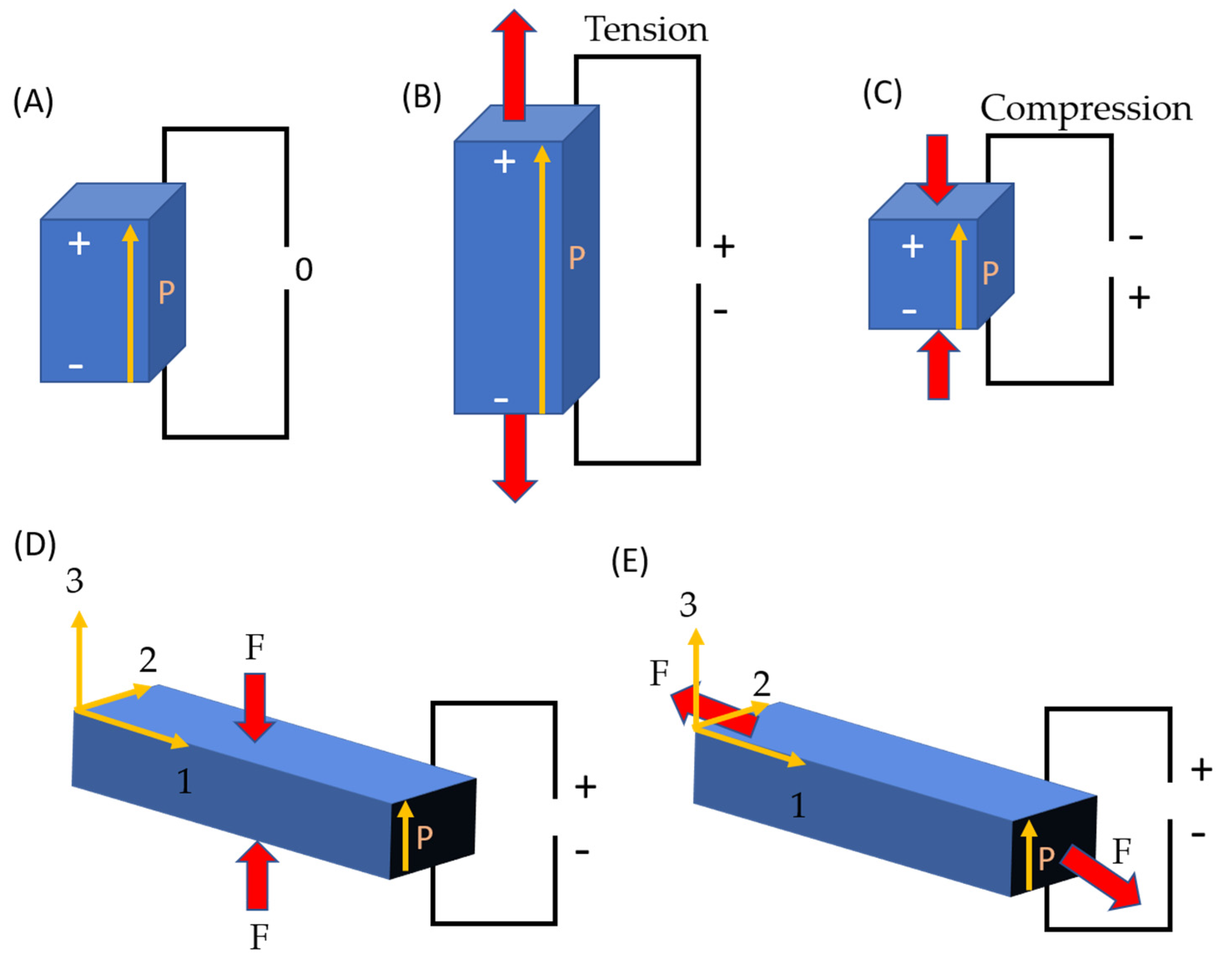

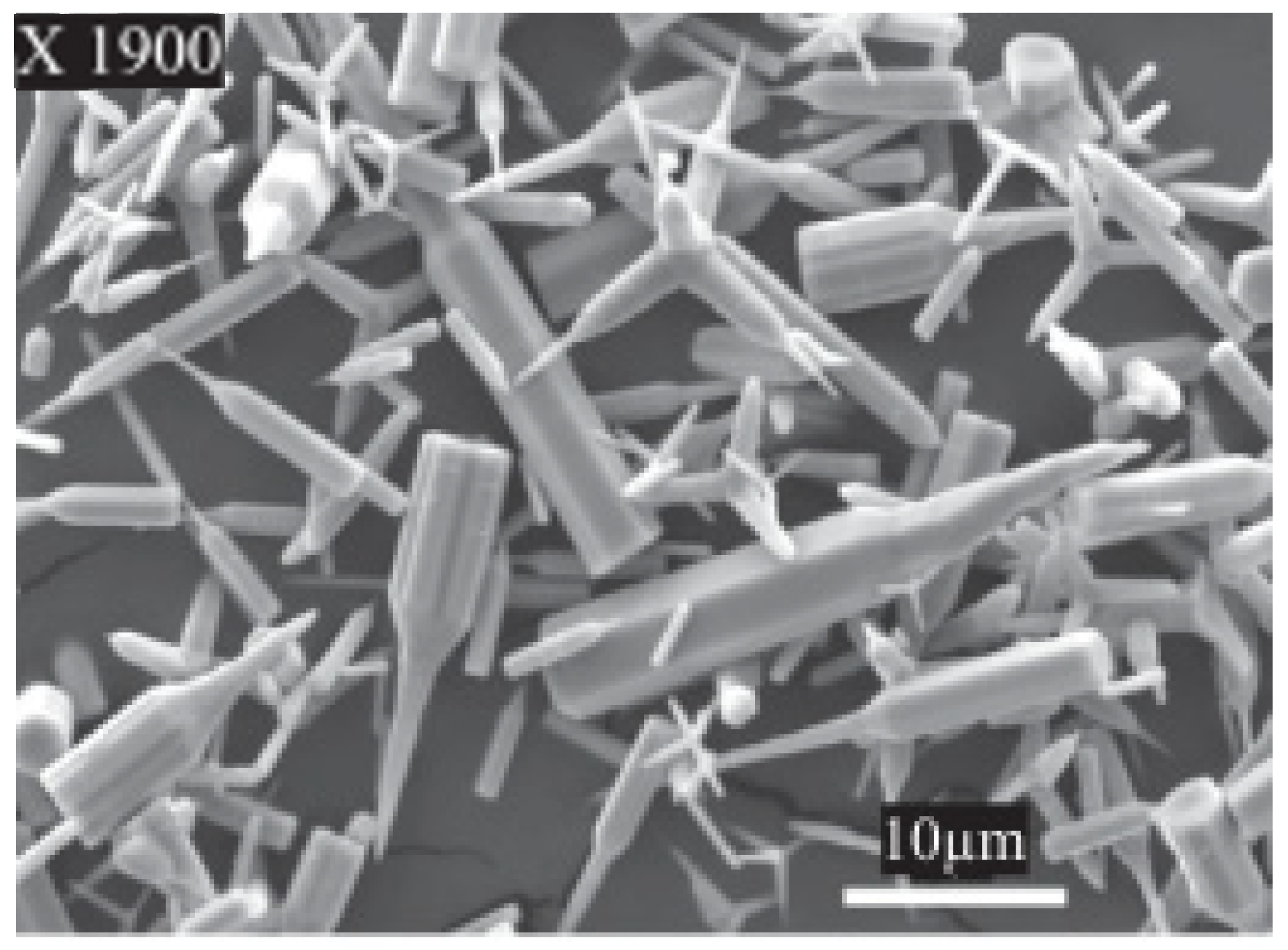
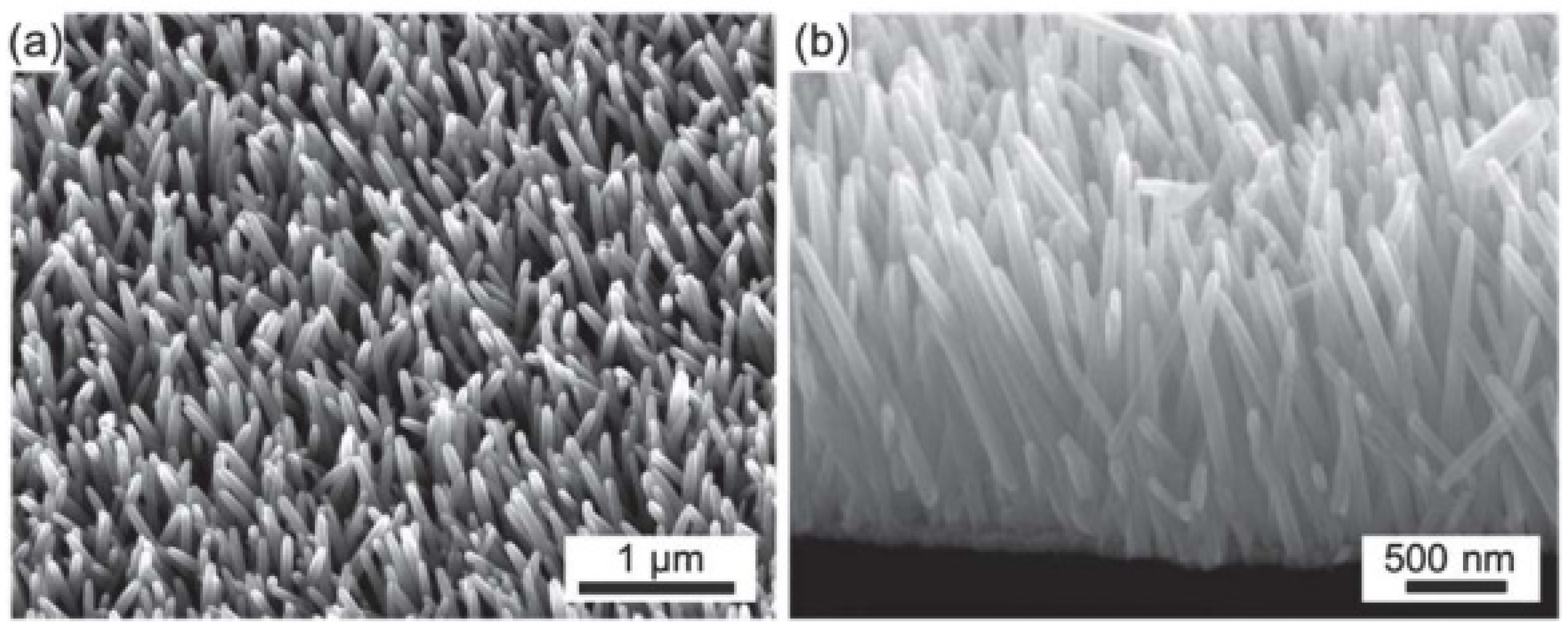
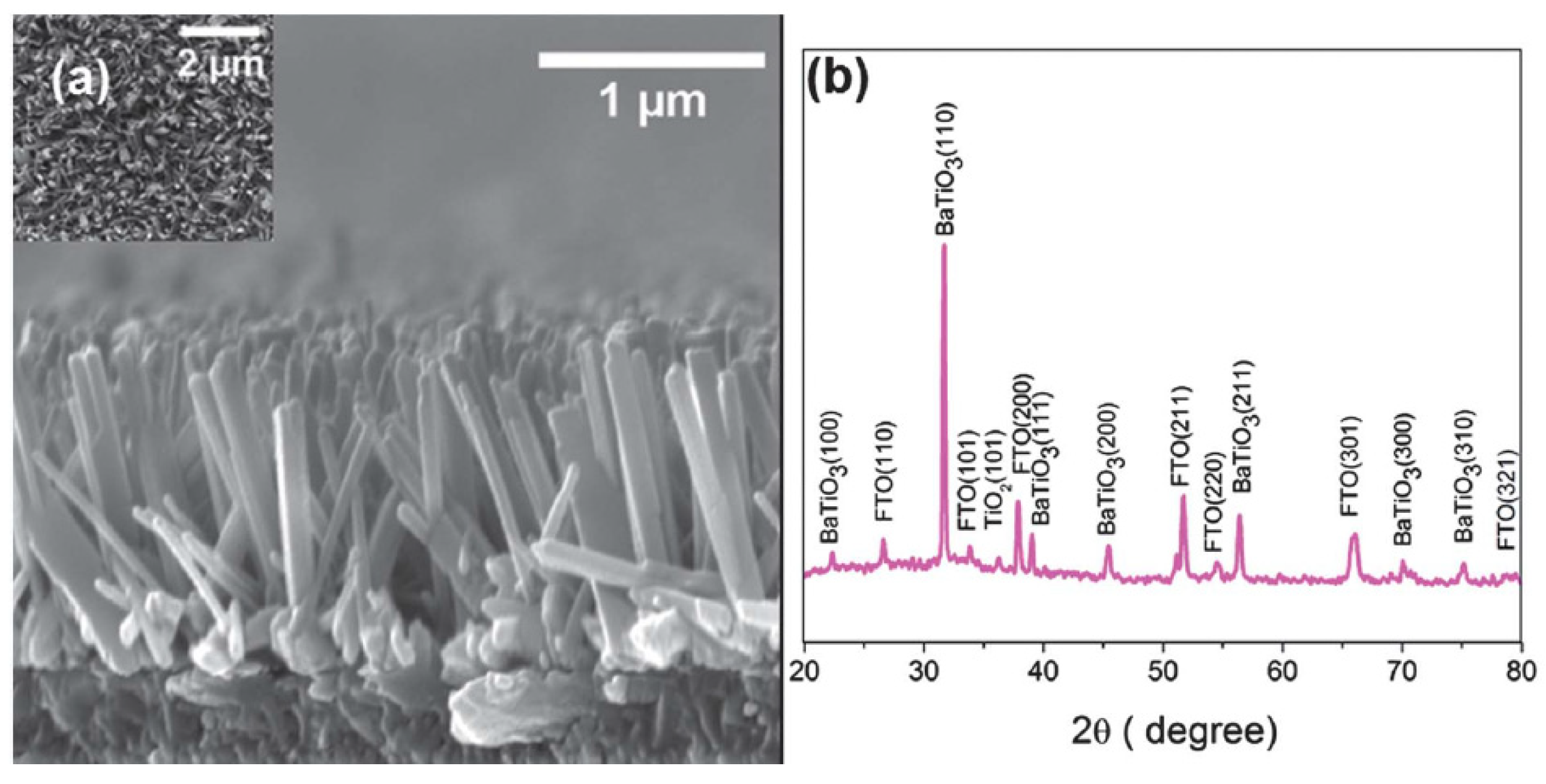



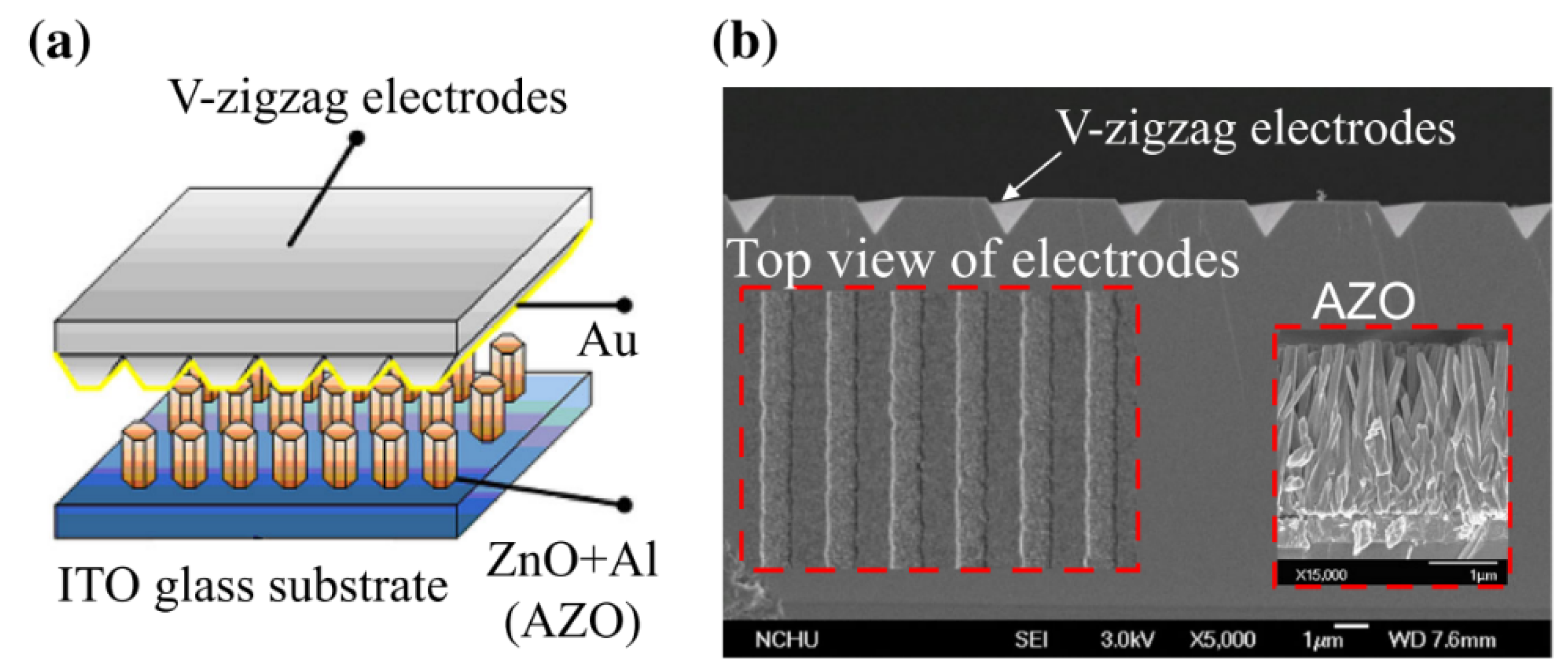
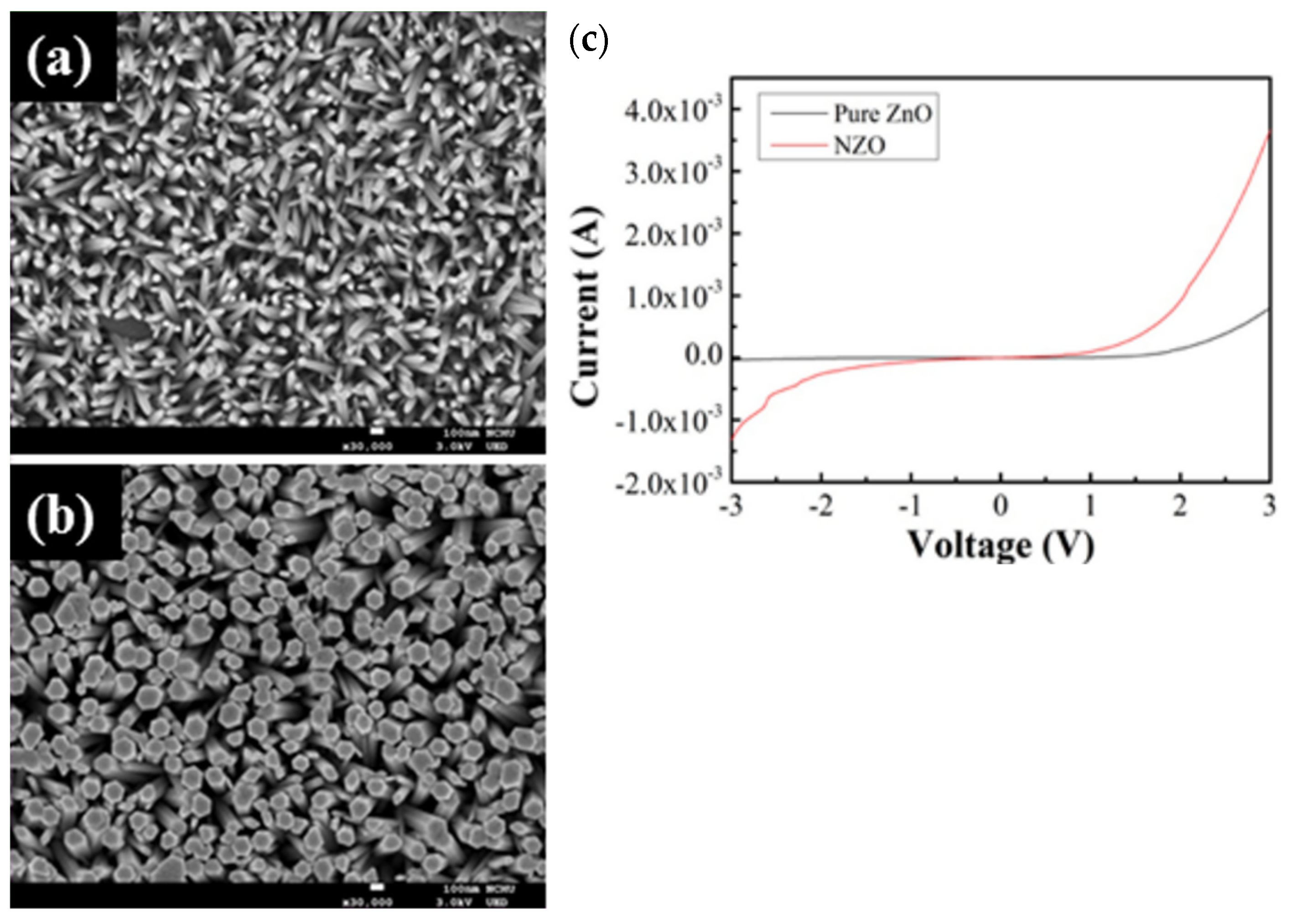

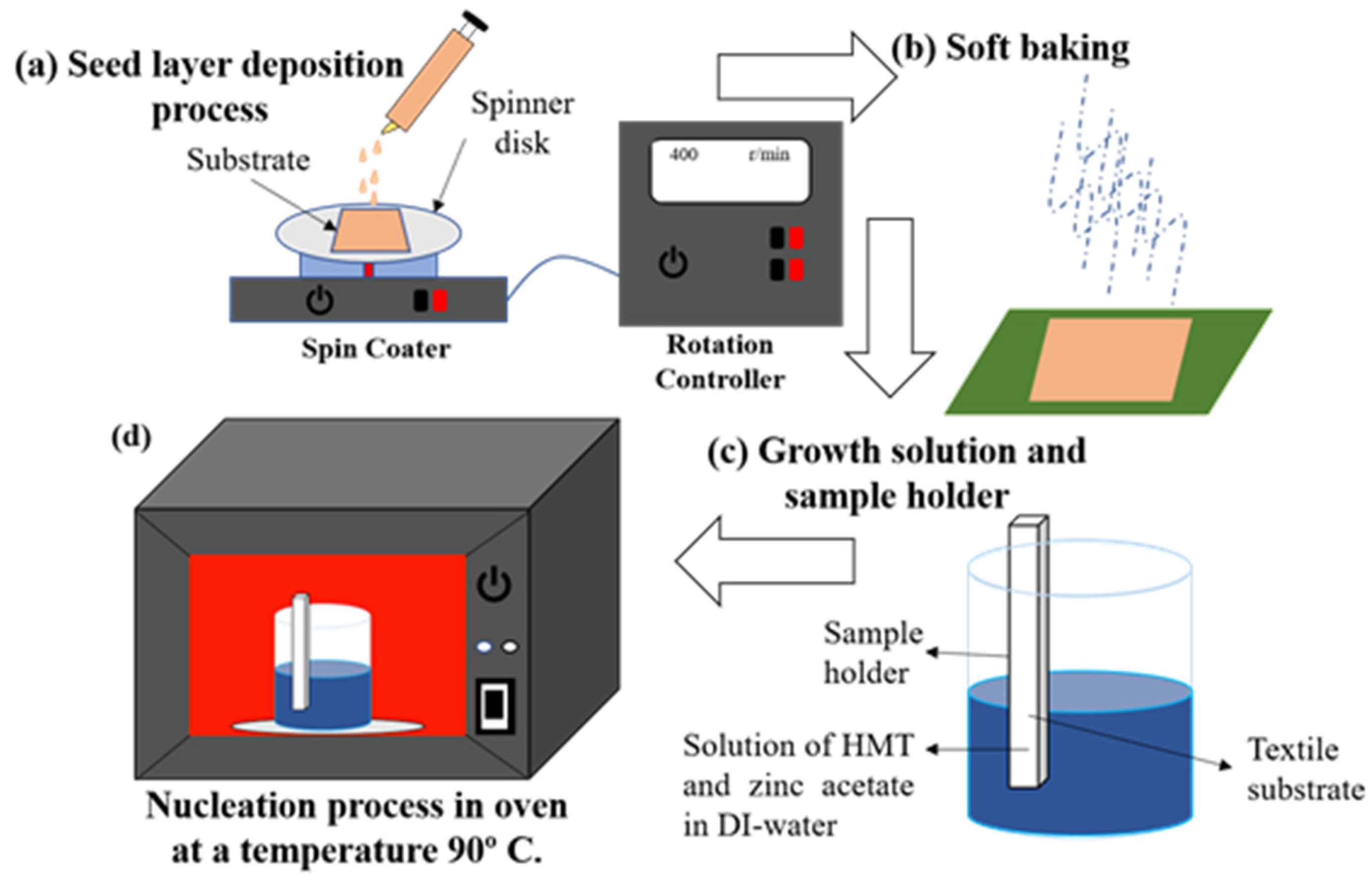
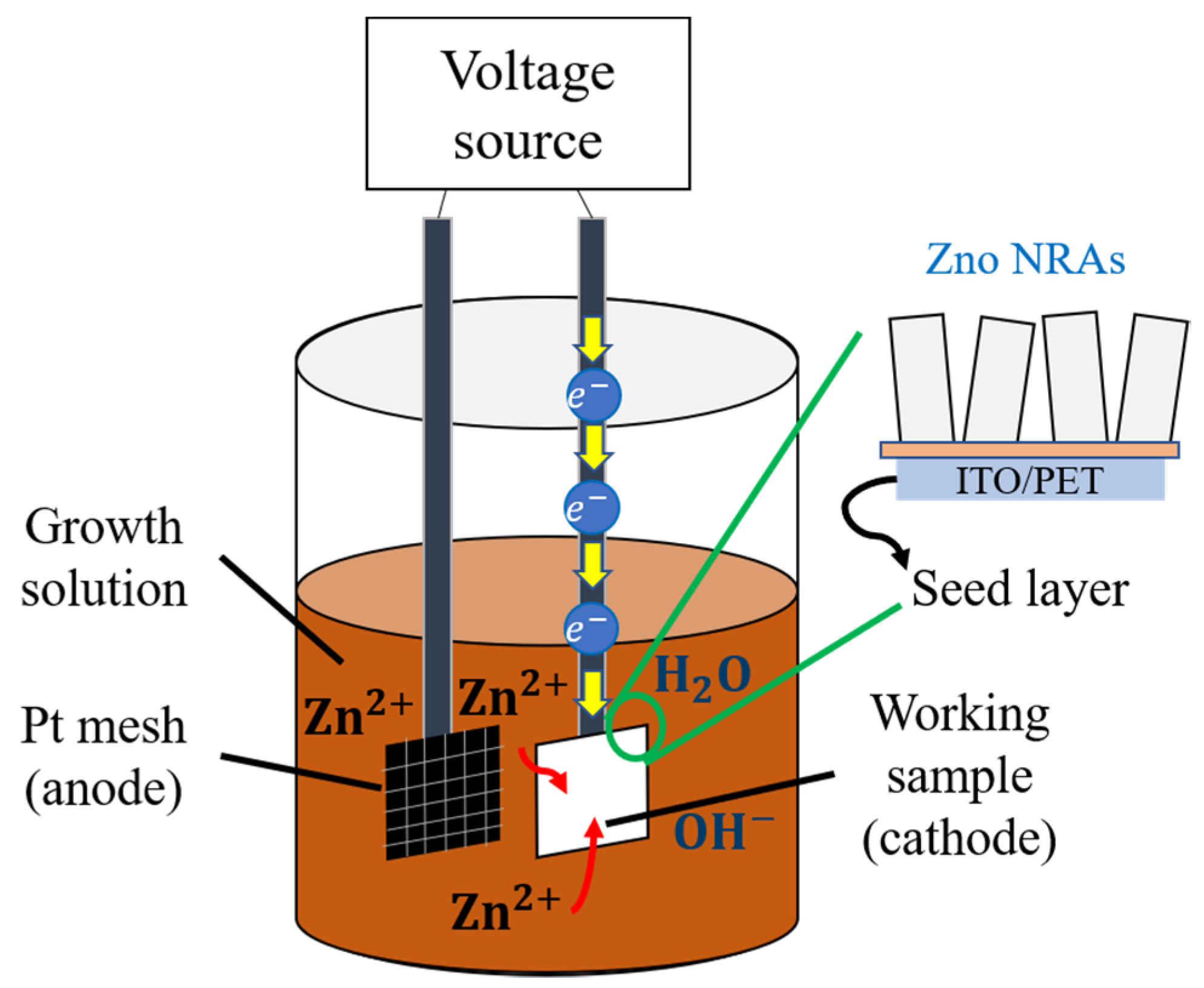
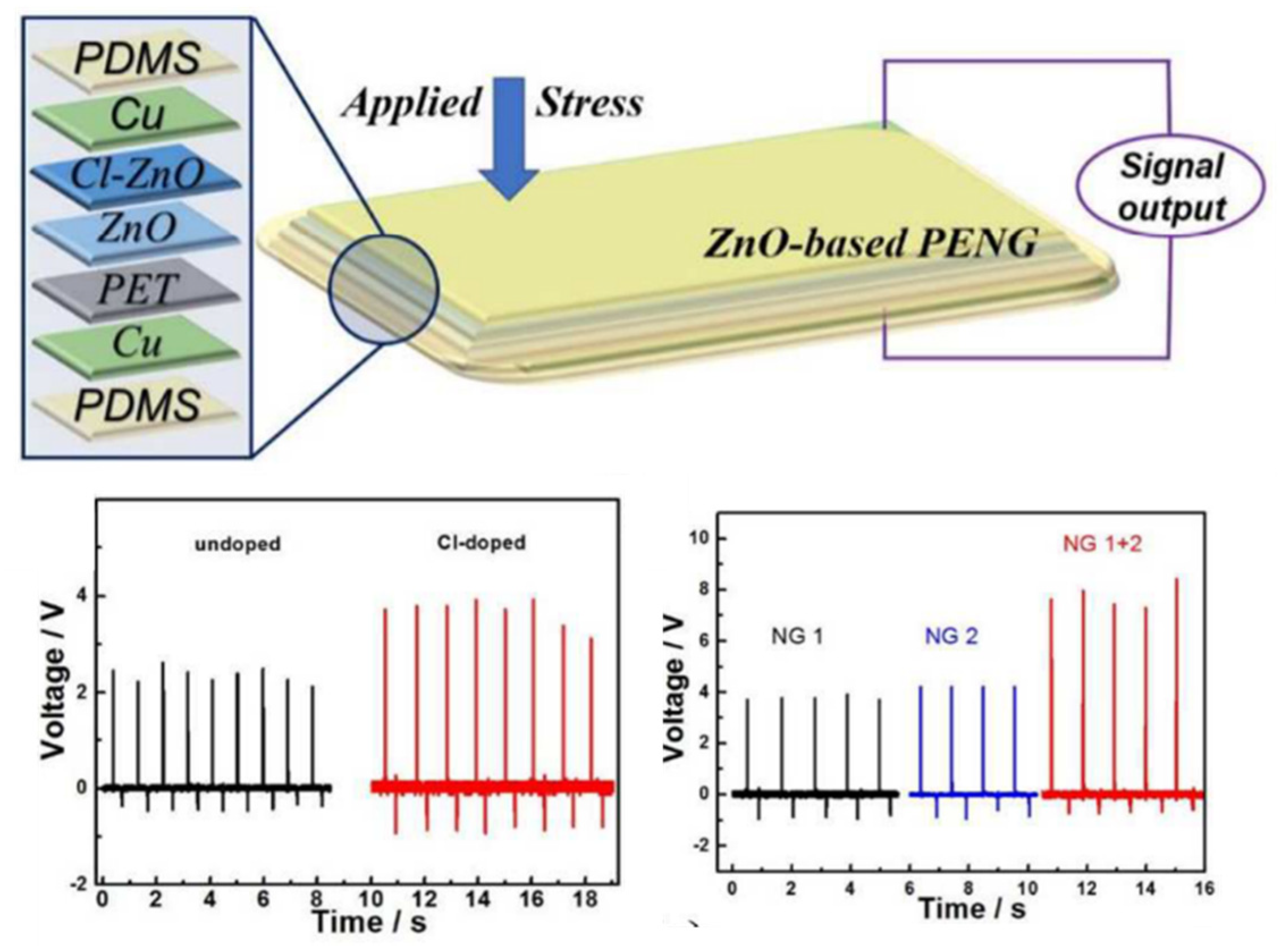
| Properties | Value |
|---|---|
| Lattice parameters at 300 K | |
| 0.325 nm | |
| 0.521 nm | |
| 1.602 (ideal hexagonal structure shows 1.633) | |
| u | 0.345 |
| Density | 5.606 g cm−3 |
| Stable phase at 300 K | Wurtzite |
| Melting point | 1975 °C |
| Thermal conductivity | 0.6, 1–1.2 |
| Linear expansion coefficient (/C) | : 6.5 × 10−6 |
| : 3.0 × 10−6 | |
| Static dielectric constant | 8.656 |
| Refractive index | 2.008, 2.029 |
| Energy gap | 3.4 eV, direct |
| Intrinsic carrier concentration | <106 cm−3 |
| Exciton binding energy | 60 meV |
| Electron effective mass | 0.24 |
| Electron Hall mobility at 300 K for low n-type conductivity | 200 cm2 V−1 s−1 |
| Hole effective mass | 0.59 |
| Hole Hall mobility at 300 K for low p-type conductivity | 5–50 cm2 V−1 s−1 |
| No | Material | Substrate | Method | Geometry D: Diameter L: Length | Aspect Ratio | Output Voltage [V] | Power Density [Wcm−2] | Ref | Year |
|---|---|---|---|---|---|---|---|---|---|
| 1 | ZnO NRs | Kapton | Hydrothermal | D: 64 nm L: 1.7 µm | 27 | 400 m | 9 µ | [44] | 2017 |
| 2 | ZnO NRs | Quartz tube | Chemical vapor deposition | D: 57 nm, L: 3.9 µm | 68 | 0.74 | 8.97 µ | [43] | 2019 |
| 3 | BaTiO3 NWs | FTO Glass | Hydrothermal | D: 90 nm, L: 1 µm | 11 | 311.5 m | 6.27 µ | [48] | 2014 |
| 4 | ZnO NRs/PEDOT:PSS | PET | Thermal evaporation | D: 64 nm, L: 1 µm | 16 | 90 m | 5.2 µ | [45] | 2013 |
| 5 | ZnO NRs | Sapphire | Vapor liquid solid | D: 100 nm, L: 1 µm | 10 | 42.5 m | 0.4 µ | [34] | 2014 |
| 6 | ZnO NRs/PMMA | PET | Spin coating | D: 64 nm, L: 1.2 µm | 19 | 252 m | 0.02 µ | [45] | 2013 |
| 7 | ZnO NRs | Electrospun PVDF fibers | Hydrothermal | D: 30 nm, L: 183 nm | 6 | 79.95 m | 0.91 n | [58] | 2018 |
| 8 | ZnO NRs | Terylene-fabric | Hydrothermal | D: 200 nm, L: 5 µm | 25 | 10 m | [59] | 2014 | |
| 9 | BaTiO3 nanotube | Titanium | Hydrothermal | D: 144 nm, L: 6 µm | 42 | 6.3 m | [60] | 2020 | |
| 10 | ZnO NRs | Cotton Fabric | Aqueous chemical growth | D: 200 nm | 9.5 m | [61] | 2012 | ||
| 11 | PZT nanofibers | Silicon | Electrospinnig process | D: 100 nm, L: 85 µm | 0.4 m | [62] | 2009 | ||
| 12 | Indium nitride nanowire | Silicon | D: 43 nm | 825 µ | 2.9 n | [50] | 2017 | ||
| 13 | Indium nitride | 0.195 | 73 m | [51] | 2021 | ||||
| 14 | Zinc sulfide nanosheets | flexible aluminum | Hydrothermal | 600 m | 219.5 n | [52] | 2021 | ||
| 15 | Zinc sulfide nanofibers | Hydrothermal | D: 600 nm | 3 | [53] | 2020 |
| No | Material | Substrate | Method | Geometry D: Diameter L: Length | Aspect Ratio | Output Voltage [V] | Power Density [Wcm−2] | Ref | Year |
|---|---|---|---|---|---|---|---|---|---|
| 1 | Ni-Doped ZnO NRs | Glass | Chemical bath deposition | L: 1.72 µm | 0.07 | 735 m | [68] | 2020 | |
| 2 | Ag-doped ZnO NRs | cotton fabric | Hydrothermal | D: 86 nm | 6.85 | 1.45 m | [64] | 2019 | |
| 3 | Al-doped ZnO NRs | Glass | Chemical aqueous solution | L: 1.81 µm | 1.35 m | 1.026 n | [65] | 2015 | |
| 4 | Al-doped ZnO NRs | Glass | Chemical solution | D: 70 nm, L: 1.75 µm | 25 | 60 m | 0.84 n | [81] | 2010 |
| 5 | Ag-doped ZnO NRs | PET | Hydrothermal | D: 110 nm, L: 2.02 µm | 18 | 5.2 m | [82] | 2017 | |
| 6 | PVDF-HFP/Ni-doped ZnO nanocomposites | Hydrothermal | 1.2 | [69] | 2017 | ||||
| 7 | Neodymium (Nd)-doped ZnO NRs | PET | Wet chemical coprecipitation | D: 101 nm L: 412 nm | 4 | 31 | [70] | 2018 | |
| 8 | La-doped ZnO | Wet chemical | D: 60 nm | 1.6 | 50 m | [71] | 2019 | ||
| 9 | Tb-doped ZnO nanotapers | Wet chemical coprecipitation | 2.3 | [72] | 2020 | ||||
| 10 | Ce-doped ZnO nanoparticles | Wet chemical solution | D: 18 nm L: 100 nm | 6 | 2.5 | [73] | 2014 | ||
| 11 | Vanadium-doped ZnO nanosheet | PET | Cost-effective seed-assisted solution | D: 100 nm L: 1.5 µm | 15 | [74] | 2013 | ||
| 12 | Ba-doped ZnO NRs | Wet chemical coprecipitation | D: 73.25 nm L: 476.51 nm | 7 | 10.5 | [75] | 2021 | ||
| 13 | Ga-doped ZnO NRs | PES | An aqueous solution | D: 75 nm | [76] | 2012 | |||
| 14 | Cr-doped ZnO NRs | Wet chemical solution | D: 300 nm | 8 m | [77] | 2014 | |||
| 15 | S-doped ZnO NRs | Hydrothermal | L: 2 µm | 150 m | 24 n | [78] | 2022 |
Publisher’s Note: MDPI stays neutral with regard to jurisdictional claims in published maps and institutional affiliations. |
© 2022 by the authors. Licensee MDPI, Basel, Switzerland. This article is an open access article distributed under the terms and conditions of the Creative Commons Attribution (CC BY) license (https://creativecommons.org/licenses/by/4.0/).
Share and Cite
Mustaffa, M.A.; Arith, F.; Noorasid, N.S.; Zin, M.S.I.M.; Leong, K.S.; Ali, F.A.; Mustafa, A.N.M.; Ismail, M.M. Towards a Highly Efficient ZnO Based Nanogenerator. Micromachines 2022, 13, 2200. https://doi.org/10.3390/mi13122200
Mustaffa MA, Arith F, Noorasid NS, Zin MSIM, Leong KS, Ali FA, Mustafa ANM, Ismail MM. Towards a Highly Efficient ZnO Based Nanogenerator. Micromachines. 2022; 13(12):2200. https://doi.org/10.3390/mi13122200
Chicago/Turabian StyleMustaffa, Mohammad Aiman, Faiz Arith, Nur Syamimi Noorasid, Mohd Shahril Izuan Mohd Zin, Kok Swee Leong, Fara Ashikin Ali, Ahmad Nizamuddin Muhammad Mustafa, and Mohd Muzafar Ismail. 2022. "Towards a Highly Efficient ZnO Based Nanogenerator" Micromachines 13, no. 12: 2200. https://doi.org/10.3390/mi13122200
APA StyleMustaffa, M. A., Arith, F., Noorasid, N. S., Zin, M. S. I. M., Leong, K. S., Ali, F. A., Mustafa, A. N. M., & Ismail, M. M. (2022). Towards a Highly Efficient ZnO Based Nanogenerator. Micromachines, 13(12), 2200. https://doi.org/10.3390/mi13122200









